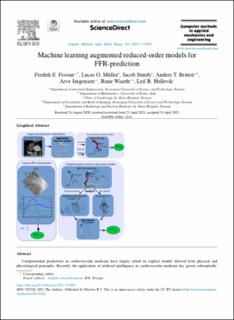| dc.contributor.author | Fossan, Fredrik Eikeland | |
| dc.contributor.author | Müller, Lucas O. | |
| dc.contributor.author | Sturdy, Jacob | |
| dc.contributor.author | Bråten, Anders Tjellaug | |
| dc.contributor.author | Jørgensen, Arve | |
| dc.contributor.author | Wiseth, Rune | |
| dc.contributor.author | Hellevik, Leif Rune | |
| dc.date.accessioned | 2021-09-24T08:18:29Z | |
| dc.date.available | 2021-09-24T08:18:29Z | |
| dc.date.created | 2021-06-13T14:34:57Z | |
| dc.date.issued | 2021 | |
| dc.identifier.citation | Computer Methods in Applied Mechanics and Engineering. 2021, 384, 1-30. | en_US |
| dc.identifier.issn | 0045-7825 | |
| dc.identifier.uri | https://hdl.handle.net/11250/2781313 | |
| dc.description.abstract | Computational predictions in cardiovascular medicine have largely relied on explicit models derived from physical and physiological principles. Recently, the application of artificial intelligence in cardiovascular medicine has grown substantially. However, successful application of purely data-driven methods requires a sufficiently large and rich dataset. An alternative to purely data-driven methods is to incorporate prior physics-based knowledge into the learning process to reduce the amount and quality of data necessary for a performant model. We analyzed the benefit of this alternative for prediction of pressure and flow in pathological coronary arteries. We trained fully-connected feed forward neural networks (NN) to predict pressure losses in coronary arteries. The training and test data were obtained by solving the incompressible Navier–Stokes () equations. The coronary flow and various geometrical data were used as inputs to train a purely data-driven NN. We investigated two methods for incorporation of prior physics-based knowledge from a reduced-order model () into NNs that predicted pressure losses across stenotic and healthy coronary segments. First, we trained NNs to predict the discrepancy between the and pressure loss. Second, we augmented the data by including the pressure loss prediction as an input feature to a NN that predicted pressure. Both approaches for incorporation of prior knowledge from the significantly improved prediction of pressure losses across healthy and stenotic segments relative to the purely data-driven approach, especially for lower amounts of data. The incorporation of NN predictions of coronary segment pressure losses in a coronary network model resulted in Fractional Flow Reserve (FFR) predictions with error standard deviation of 0.021 with respect to FFR. In comparison, the standard deviation of repeated FFR measurements is 0.018. | en_US |
| dc.language.iso | eng | en_US |
| dc.publisher | Elsevier Science | en_US |
| dc.rights | Navngivelse 4.0 Internasjonal | * |
| dc.rights.uri | http://creativecommons.org/licenses/by/4.0/deed.no | * |
| dc.title | Machine learning augmented reduced-order models for FFR-prediction | en_US |
| dc.type | Peer reviewed | en_US |
| dc.type | Journal article | en_US |
| dc.description.version | publishedVersion | en_US |
| dc.source.pagenumber | 1-30 | en_US |
| dc.source.volume | 384 | en_US |
| dc.source.journal | Computer Methods in Applied Mechanics and Engineering | en_US |
| dc.identifier.doi | 10.1016/j.cma.2021.113892 | |
| dc.identifier.cristin | 1915449 | |
| dc.source.articlenumber | 113892 | en_US |
| cristin.ispublished | true | |
| cristin.fulltext | original | |
| cristin.qualitycode | 2 | |

